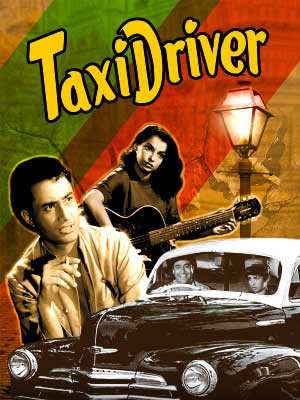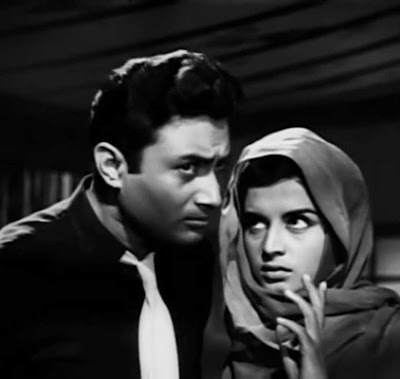No, not that one. This
came years before and is set in Bombay where two small insignificant people
try and find a place for themselves in a big city. One of the pleasures of
this film is seeing so much of Bombay as the taxi driver roams the streets
of Bombay looking for fares. At the time in 1954 the populating was about
3.5 million - today it is over 20 million. It looked very livable back them
- wide boulevards with little traffic, all large American cars, prominent
buildings, the beaches nearby, the bungalows and duplexes. But there were
still the poor and the working class struggling to make a go of things. Our
two subjects are fairly rootless without the large family to fall back on
when times get tough. But friends fill in.
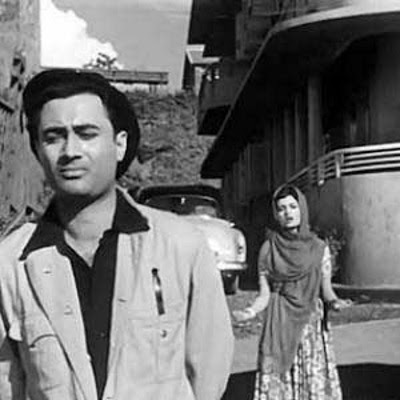
The 1950s were an interesting time for Bollywood films - often termed the
Golden Age - but I have only seen a few. They are not easily available. India
had gained its Independence in 1947 and it was a country looking for its
identity as a new nation. There was also social upheaval happening with leftist
movements driving much of the electoral base and political thinking. The
nation was also slowly transitioning from a rural society to an urban one.
This is reflected very much in the cinema. Much of it centers around the
working class or the rural poor. The dispossessed. By the 1960s the movies
moved away from this theme and often centered around the wealthy and their
huge mansions and opulent lifestyle. In ravishing color which few films from
the 1950s had.
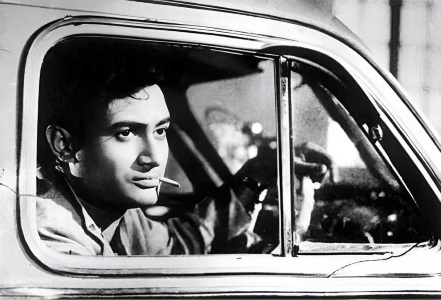
This is a lovely film in which very little happens except two people inevitably
drawn to one another. No great dramas. No over the top melodrama. Just life.
Some good moments, some not. With songs thrown in of course. But even then,
they are very natural - no fantasy numbers, no traveling to Switzerland,
no large ensemble pieces with loads of beautiful dancing girls. The film
was produced by Navketan Films, formed in 1949 by the Anand Brothers. Chetan
was the older brother and directs this, the younger brother is Vijay who
scripted this film and was later to direct classics like Guide, The Jewel
Thief and perhaps my favorite Bollywood film, Teesri Manzil. The face to
the public though was Dev Anand who would become one of the most famous actors
in Bollywood history. In the 1950s Bollywood male actors were dominated by
the Big Three - Raj Kapoor, Dilip Kumar and Ashok Kumar. By the end of the
50s into the early 60s, a new generation of younger, more urbane hipper actors
were coming to the fore with Dev and Shammi Kapoor. Dev came first and his
characters are typically contemporary, urban, fast-talking, quick witted,
stylish and often a bit of a rascal.
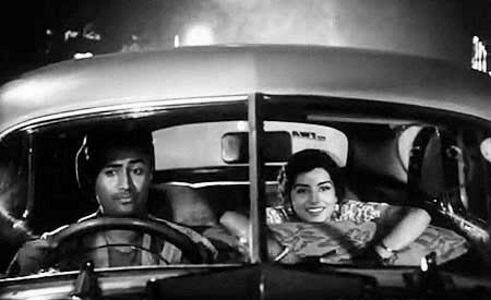
Mangal (Dev) is the taxi driver in this one. Living on the whims of luck
and passengers. A good man who looks out for all his friends even when times
are tough for him. Always ready with ten rupees for a friend. He lives in
a one room bungalow apartment down a small quiet lane. After driving for
hours, his Cheers is a lower working-class bar where the patrons play cards,
gamble away their wife's jewelry, where people are as likely to draw a knife
as a royal flush. Men come to be with friends and get away from nagging
wives. But there is also Sylvie (Sheila Ramani) who is the entertainment
- singing and slow dancing by herself, giving Mangal looks of smoldering
heat like an inside fast ball - looking like a sultry Indian Ava Gardner.
But this is Bollywood and the "bad" girl never gets the good guy - though
in truth she has a heart of gold. But she is tainted by her profession. His
best friend is the comic relief (the legendary Johnny Walker) who tells another
friend that he is lucky his possible wife has a bad leg - she will never
be able to run away.
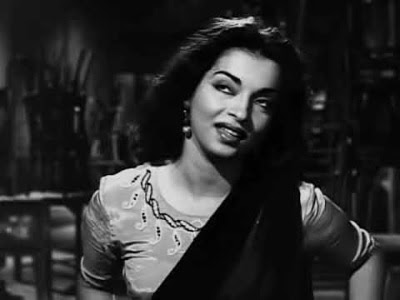
One day Mangal picks up three passengers - two men and a woman - and they
have him drive outside of Bombay to a lonely patch of palm trees and beach.
They have told the woman Mala that this is where the Indian composer lives
that she is looking for. Instead, they try and rape her but Mangal intervenes
and is now stuck with her. She has no family, no money - came from the hinterlands
to be a singer - and so he lets her stay in his room while he sleeps in the
taxi. In the daytime, they try and track down the composer with no luck.
Having her stay with him is scandalous, so they cut her hair, dress her up
as a man and he tries to teach her how to smoke and curse - every fifth word
should be damn - with little success. She is way too cute. Mala is played
by Kalpana Kartik. She was originally Mona Singha, a Punjabi Christian, who
Chetan discovered and convinced to be in his film Baazi, directed by Guru
Dutt. During the filming of this, she and Anand skipped out and got married
and stayed that way till his death in 2011.
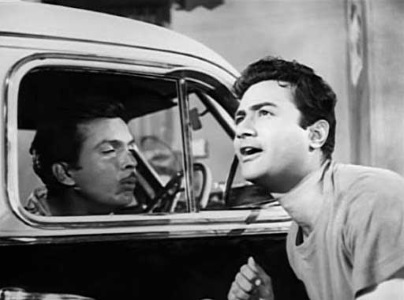
There are a few small dramas along the way - she leaves because she thinks
he loves Sylvie, some gangsters come after both of them, they find the composer
but the ending - as sloppy as it is with a big brawl in the club - is inevitable.
The composer for this film is the great S.D. Burman, father of R.D. Burman
and the singers are Lata and her sister Asha trading off songs. For a Bollywood
film it only runs 133 minutes and I enjoyed it a lot though it was the mood
of it, the location shooting, the understated performances that won me over.
In the opening credits they put down Bombay as Guest Appearances and it is
the heart of this film.
